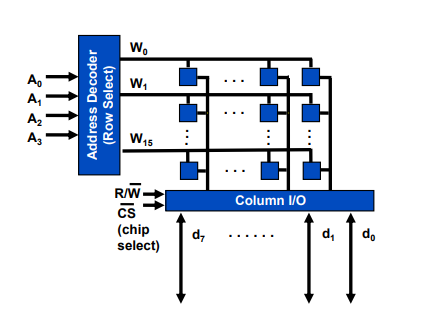The Designer’s Dilemma
Refer to CS132.
Memory Hierarchy
Memory hierarchy is the same as in CS132, but we go more into detail on why we have one.
Why have a hierarchy?
- Economics: we don’t have infinite money, so we can’t build ultra-fast ultra-high capacity memory. Therefore, we have a hierarchy with trade-offs between capacity and access times.
- Temporal Locality & Spatial Locality lead to cache-based devices in the memory hierarchy having very good access times
- Temporal Locality: Memory location being referenced means it’s likely it’ll be referenced again
- Spatial Locality: Memory location being referenced means it’s likely nearby memory will be referenced again
- arrays have good spatial locality because it is a contiguous block of memory
Organisation of a Memory Chip
Array is organised in words of bits.

If , then each word above will contains 8 bits.
Example 1: will contain 8 bits
Example 2: The entire block of memory contains bits of memory.
Choices in Memory Chip Organisation
Example: Consider a 1 kilobit device, that reads in 1 byte at a time.
First, know that
- 1 kilobit = 1024 bits
- 1 byte = 8 bits
How many output pins do we have?
How many rows/words do we have?
How many addressing bits do we need?
Exam
This is often an exam question.
Minimising Address Decoding Space
Row Buffer is a cache for storing the entire row that is retrieved from the array.
Holes
Grounding chips? Why required?
- Look at DRAM chip from W. Stallings